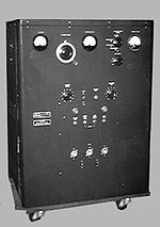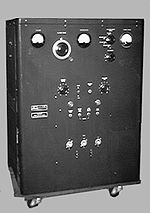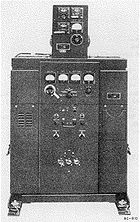
BC-610
Encyclopedia
The BC-610 was a radio
transmitter used by the U.S. Army Signal Corps during World War II
.

HT-4 transmitter was chosen from units available from various U.S. radio manufacturers. The HT-4 was designed for amateur radio
use and had been commercially available for several years at a price of approximately $700, rivaling the cost of a car. It was considered compact and stable for its era and could deliver 325 watt
s of power for voice communications and 450 watts during Morse code
operation. It was quartz crystal controlled, but was able to work over a wide range of frequencies through optimal use of the master-oscillator power amplifier.
Modifications requested by the Signal Corps' were performed by Hallicrafters' engineers working with U.S. Army technicians at Fort Monmouth
. Adapting the transmitter to military use required augmenting the basic unit with more electronic devices that permitted the transmitter to handle a wider range of frequencies and standardizing control equipment. This new version of the HT-4 became known as the BC-610 transmitter, a part of the SCR-299
mobile communications unit, and production began in 1942. General Dwight Eisenhower credited the SCR-299 in his successful reorganization of the American forces and final defeat of the Nazis at Kasserine Pass. The SCR-299 was also used in the Invasion of Sicily and later, Italy. Over 25,000 units were produced by Hallicrafters and other allied companies. In 1944, a short subject
film was produced by the Jam Handy Organization and sponsored by the Hallicrafters Company detailing how the HT-4 transmitter was adapted for military service and dramatizing its use by the U.S. military during World War II.

The "A" through "I" models are the same basic unit with relatively minor component and cosmetic differences.
Radio
Radio is the transmission of signals through free space by modulation of electromagnetic waves with frequencies below those of visible light. Electromagnetic radiation travels by means of oscillating electromagnetic fields that pass through the air and the vacuum of space...
transmitter used by the U.S. Army Signal Corps during World War II
World War II
World War II, or the Second World War , was a global conflict lasting from 1939 to 1945, involving most of the world's nations—including all of the great powers—eventually forming two opposing military alliances: the Allies and the Axis...
.

History
In the early 1940s, the U.S. military sought a high-powered radio transmitter capable of infallible voice communications over 100 miles (160 km), sturdy enough to work in all conditions, flexible enough to cover a wide range of frequencies, self-powered and able to operate in motion or at fixed locations. The HallicraftersHallicrafters
The Hallicrafters Company manufactured, marketed, and sold radio equipment beginning in 1932. The company was based in Chicago, Illinois, USA.-History:William J. Halligan founded his own radio manufacturing company in Chicago in late 1932...
HT-4 transmitter was chosen from units available from various U.S. radio manufacturers. The HT-4 was designed for amateur radio
Amateur radio
Amateur radio is the use of designated radio frequency spectrum for purposes of private recreation, non-commercial exchange of messages, wireless experimentation, self-training, and emergency communication...
use and had been commercially available for several years at a price of approximately $700, rivaling the cost of a car. It was considered compact and stable for its era and could deliver 325 watt
Watt
The watt is a derived unit of power in the International System of Units , named after the Scottish engineer James Watt . The unit, defined as one joule per second, measures the rate of energy conversion.-Definition:...
s of power for voice communications and 450 watts during Morse code
Morse code
Morse code is a method of transmitting textual information as a series of on-off tones, lights, or clicks that can be directly understood by a skilled listener or observer without special equipment...
operation. It was quartz crystal controlled, but was able to work over a wide range of frequencies through optimal use of the master-oscillator power amplifier.
Modifications requested by the Signal Corps' were performed by Hallicrafters' engineers working with U.S. Army technicians at Fort Monmouth
Fort Monmouth
Fort Monmouth was an installation of the Department of the Army in Monmouth County, New Jersey. The post is surrounded by the communities of Eatontown, Tinton Falls and Oceanport, New Jersey, and is located about 5 miles from the Atlantic Ocean. The post covers nearly of land, from the Shrewsbury...
. Adapting the transmitter to military use required augmenting the basic unit with more electronic devices that permitted the transmitter to handle a wider range of frequencies and standardizing control equipment. This new version of the HT-4 became known as the BC-610 transmitter, a part of the SCR-299
SCR-299
The SCR-299 was a U.S. Signal Corps mobile military communications unit used during World War II.-History:The SCR-299 replaced SCR-197 and SCR-597, and was an effort to give a long-range communication advantage to the U.S. Army and its allies...
mobile communications unit, and production began in 1942. General Dwight Eisenhower credited the SCR-299 in his successful reorganization of the American forces and final defeat of the Nazis at Kasserine Pass. The SCR-299 was also used in the Invasion of Sicily and later, Italy. Over 25,000 units were produced by Hallicrafters and other allied companies. In 1944, a short subject
Short subject
A short film is any film not long enough to be considered a feature film. No consensus exists as to where that boundary is drawn: the Academy of Motion Picture Arts and Sciences defines a short film as "an original motion picture that has a running time of 40 minutes or less, including all...
film was produced by the Jam Handy Organization and sponsored by the Hallicrafters Company detailing how the HT-4 transmitter was adapted for military service and dramatizing its use by the U.S. military during World War II.
Specifications

- Frequency coverage: 1.5 to 18 MHz
- Mode: AMAmplitude modulationAmplitude modulation is a technique used in electronic communication, most commonly for transmitting information via a radio carrier wave. AM works by varying the strength of the transmitted signal in relation to the information being sent...
, CWContinuous waveA continuous wave or continuous waveform is an electromagnetic wave of constant amplitude and frequency; and in mathematical analysis, of infinite duration. Continuous wave is also the name given to an early method of radio transmission, in which a carrier wave is switched on and off... - RFRadio frequencyRadio frequency is a rate of oscillation in the range of about 3 kHz to 300 GHz, which corresponds to the frequency of radio waves, and the alternating currents which carry radio signals...
power Output: 400 wattWattThe watt is a derived unit of power in the International System of Units , named after the Scottish engineer James Watt . The unit, defined as one joule per second, measures the rate of energy conversion.-Definition:...
s - Vacuum tubeVacuum tubeIn electronics, a vacuum tube, electron tube , or thermionic valve , reduced to simply "tube" or "valve" in everyday parlance, is a device that relies on the flow of electric current through a vacuum...
s: EimacEimacEimac is a trade mark of Eimac Products, part of the Microwave Power Products Division of Communications & Power Industries. It produces vacuum tubes for radio frequency applications such as broadcast and radar transmitters.-History:...
250TH final - Operating frequency determined by plug-in tuning units and final coils (up to three at once) in addition to FT-171B crystals
- Signal Corps RadioSignal Corps RadioSignal Corps Radios were U.S. Army military communications components that comprised "sets". Under the Army Nomenclature System, SCR initially designated "Set, Complete Radio," and later "Signal Corps Radio," though interpretations have varied over time....
sets: SCR-299, SCR-399, SCR-499, or GRC-38, AM requires BC-614 (or Hallicrafters HT-5) speech amplifier - Weight: 390 lbPound (mass)The pound or pound-mass is a unit of mass used in the Imperial, United States customary and other systems of measurement...
(177 kg) (without BC-614) - Manual: TM 11-280
The "A" through "I" models are the same basic unit with relatively minor component and cosmetic differences.
See also
- ARC-5ARC-5The AN/ARC-5 Command Radio Set is a series of radio receivers, transmitters, and accessories used to provide two-way Morse code and AM radiotelephone communication for U.S. Navy aircraft during World War II and the years following. It was an improvement of the Navy's ARA/ATA command set. Similar...
- BC-348BC-348The BC-348 is a compact American-made communications receiver, which was mass-produced during World War II for the U.S. Army Air Force. Under the Joint Army-Navy nomenclature system, the receiver system became known as the AN/ARR-11. -History:...
- BC-654BC-654The SCR-284 was a World War II era combination transmitter and receiver used in vehicles or fixed ground stations.- History :The Crosley Corporation of Cincinnati, Ohio manufactured the Signal Corps Radio set SCR-284 that consisted of the BC-654 and associated support equipment.The BC-654 first saw...
- R-390AR-390AThe R-390A /URR is a general coverage HF radio communications receiver designed by Collins Radio Company for the US military.-History:The R-390A military shortwave radio receiver was the result of a project undertaken by the U. S. Army Signal Corps in 1954 to replace the existing R-390 receiver...
- SCR-299SCR-299The SCR-299 was a U.S. Signal Corps mobile military communications unit used during World War II.-History:The SCR-299 replaced SCR-197 and SCR-597, and was an effort to give a long-range communication advantage to the U.S. Army and its allies...
- Signal Corps RadioSignal Corps RadioSignal Corps Radios were U.S. Army military communications components that comprised "sets". Under the Army Nomenclature System, SCR initially designated "Set, Complete Radio," and later "Signal Corps Radio," though interpretations have varied over time....
- Vintage amateur radioVintage amateur radioVintage amateur radio is a subset of the amateur radio hobby, considered a form of nostalgia much like antique car collecting, where enthusiasts collect, restore, preserve, build, and operate amateur radio equipment from bygone years, most notably those using vacuum tube technology.Popular modes of...

